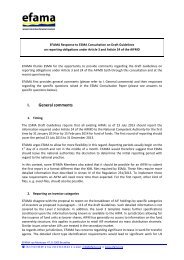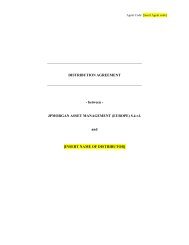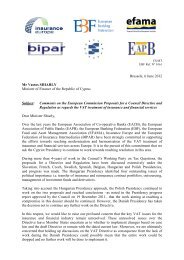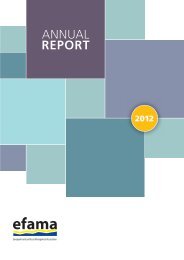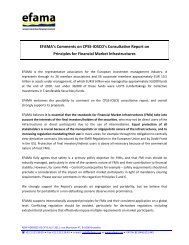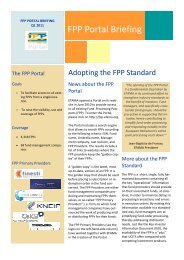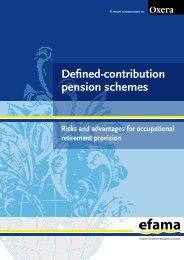EFAMA KPMG Solvency II Report
EFAMA KPMG Solvency II Report
EFAMA KPMG Solvency II Report
You also want an ePaper? Increase the reach of your titles
YUMPU automatically turns print PDFs into web optimized ePapers that Google loves.
4.3.3 Asset Valuation<br />
4 WORKING GROUP FINDINGS | 49<br />
Requirements<br />
<strong>Solvency</strong> <strong>II</strong> imposes market based valuation of assets and liabilities as well as the<br />
capital requirements. IFRS 4 Phase 2 will go some way to increase convergence<br />
between the <strong>Solvency</strong> <strong>II</strong> framework and accounting standards since it is generally<br />
expected to be more market-consistent, although much is still to be decided.<br />
Most market participants expect this will lead to increased volatility in reported results,<br />
leading to a shift away from long-term products with embedded guarantees towards<br />
products where the investment risk is born by the policyholder, and changes to<br />
re-insurance programmes.<br />
However, when looking at the relation with local GAAP, <strong>Solvency</strong> <strong>II</strong> will have a different<br />
impact in different countries across the EU. In several European countries, including<br />
Belgium and Germany, local GAAP is not fair-value based, and so <strong>Solvency</strong> <strong>II</strong> will<br />
increase the gap between regulatory capital requirements and local accounting<br />
compliance. For other countries, for instance Spain and the UK, local GAAP is more<br />
market consistent. The interplay between <strong>Solvency</strong> <strong>II</strong> and local GAAP rules may lead<br />
to confl icting views on the measurement of risk and return.<br />
Differences in accounting rules can lead to confl icting KPI’s, making optimal asset<br />
allocation less straightforward as certain trade-offs will need to be made. Furthermore,<br />
for several EU countries, the current regulatory capital framework is not truly risk-based,<br />
but rather volume-based.<br />
In these jurisdictions, asset allocation by insurers is currently not heavily impacted by<br />
capital requirements. The introduction of <strong>Solvency</strong> <strong>II</strong> will change this signifi cantly for<br />
most insurers, as capital held against fi nancial risks may account for more than 50%<br />
of their total SCR. For life insurers it is even expected that on average around 75% of<br />
the SCR will be due to fi nancial risk. Clearly, this will have implications for the strategic<br />
asset allocation of insurers.<br />
© 2012 <strong>KPMG</strong> LLP, a UK limited liability partnership, is a subsidiary of <strong>KPMG</strong> Europe LLP and a member fi rm of the <strong>KPMG</strong> network of independent member fi rms affi liated with <strong>KPMG</strong> International<br />
Cooperative, a Swiss entity. All rights reserved.





